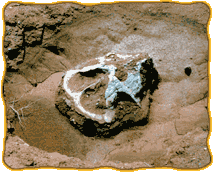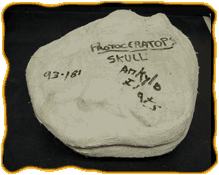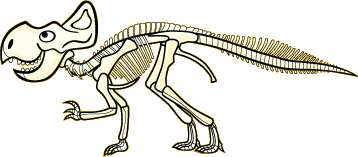


DEENA: How did they get you to New York City?
PROTO ANDY: First they excavated me. Of course, I was buried so I couldn't see what was going on, but they took a lot of pictures.
My skeleton is quite fragile, and the paleontologists didn't want to damage me. So, they put glue on me and cleared away the sand near me using picks, chisels, dental tools, and some brushes. It didn't hurt a bit.

DEENA: Did they remove you from rocks in the desert?
PROTO ANDY: Nah, that would have taken too much time. Plus, they could have damaged my lovely bones. What they did instead was use a large knife to carve out a large chunk of rock around my skeleton. Then they put a jacket on me.
DEENA: Were you cold?
PROTO ANDY: No, a different kind of jacket. In paleontology, a "jacket" is the name for the hard stuff they wrapped around me to keep me safe. They put toilet paper over me to protect my bones. Then, they wrapped me up with bandages and plaster. I looked like a mummy.
DEENA: Then, what happened?
PROTO ANDY: They put a number on my plaster jacket, wrote notes in their field book, then put me in a large box. Next, they stuck me on a truck, then a train, and finally a boat. During the trip, my fossilized bones were packed with sawdust and straw to prevent any damage. They took such good care of me!
DEENA: That was in the 1920s. Is the same method used these days?
PROTO ANDY: Pretty much. Although some of the very special fossils get sent to New York by airplane rather than by boat.




 Biodiversity
Biodiversity
 Brain
Brain
 Genetics
Genetics
 Marine BiOLogy
Marine BiOLogy
 MicrobiOLogy
MicrobiOLogy
 PaleontOLogy
PaleontOLogy
 ZoOLogy
ZoOLogy
 AnthropOLogy
AnthropOLogy
 ArchaeOLogy
ArchaeOLogy
 Astronomy
Astronomy
 Climate Change
Climate Change
 Earth
Earth
 Physics
Physics
 Water
Water







